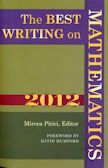This annual anthology brings together the year’s finest mathematics writing from around the world.
Featuring promising new voices alongside some of the foremost names in the field,
The Best Writing on Mathematics 2014 makes available to a wide audience many articles
not easily found anywhere else—and you don’t need to be a mathematician to enjoy them.
These writings offer surprising insights into the nature, meaning, and practice of mathematics today.
They delve into the history, philosophy, teaching, and everyday occurrences of math,
and take readers behind the scenes of today’s hottest mathematical debates.
Here John Conway presents examples of arithmetical statements that are almost certainly true but likely unprovable;
Carlo Séquin explores, compares, and illustrates distinct types of one-sided surfaces known as Klein bottles;
Keith Devlin asks what makes a video game good for learning mathematics and shows why many games fall short of that goal;
Jordan Ellenberg reports on a recent breakthrough in the study of prime numbers;
Stephen Pollard argues that mathematical practice, thinking, and experience transcend the utilitarian value of mathematics;
and much, much more.




